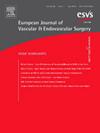综合栓塞保护下经颈动脉再灌注过程中颈内动脉血流方向的经颅双工评价。
IF 5.7
1区 医学
Q1 PERIPHERAL VASCULAR DISEASE
European Journal of Vascular and Endovascular Surgery
Pub Date : 2025-06-01
DOI:10.1016/j.ejvs.2025.01.045
引用次数: 0
摘要
目的:本研究的目的是报告经颅双工(TCD)评估经颈动脉重建术(TCAR)中岩状颈内动脉(ICA)血流的结果。同时评估30天的临床结果。方法:回顾性回顾了所有连续患者的两个中心数据库,这些患者在TCAR期间使用改良的Neuroguard IEP (Contego Medical, Raleigh, NC, USA)三合一装置和选择性血流逆转对ICA岩段进行TCD评估。这种新型颈动脉支架具有综合栓塞保护(IEP)系统,该手术被称为TCAR-IEP。研究的主要终点是是否实现血流逆转,次要终点是手术技术成功和30天卒中和/或死亡。结果:2023年1 - 5月,连续22例患者(平均年龄72岁;16例(73%)男性接受了TCAR-IEP,同时对同侧岩质ICA进行了TCD评估。在这些患者中,有16例(73%)有足够的颞骨窗,可以在手术前对ICA的岩段进行充分的双工扫描。在颈总动脉(CCA)夹紧和侧口打开以增加压差后,尽管所有患者在8f颈总动脉鞘中存在逆行血流,但只有8例患者(50%)在同侧岩质ICA中表现出血流逆转。技术上的成功率是100%。在干预后的前30天内未观察到重大中风或死亡。结论:在本研究中,尽管目视观察到CCA鞘内有逆行血流,但相当比例的患者在TCAR期间没有出现远端ICA血流逆转。在所有患者中增加远端栓塞保护对于有效降低卒中风险似乎是合理的。本文章由计算机程序翻译,如有差异,请以英文原文为准。
Transcranial Duplex Evaluation of Internal Carotid Artery Flow Direction during Transcarotid Artery Revascularisation with Integrated Embolic Protection
Objective
The aim of this study was to report the findings of transcranial duplex (TCD) evaluation of petrous internal carotid artery (ICA) flow during transcarotid artery revascularisation (TCAR). Thirty day clinical results were also evaluated.
Methods
A two centre database of all consecutive patients who had TCD evaluation of the petrous segment of the ICA during TCAR with a modified approach using the Neuroguard IEP (Contego Medical, Raleigh, NC, USA) three in one device and selective flow reversal was reviewed retrospectively. This novel carotid stent has an integrated embolic protection (IEP) system, and the procedure has been termed TCAR-IEP. The study primary endpoint was the achievement or not of flow reversal, and secondary endpoints were procedural technical success and 30 day stroke and or death.
Results
Between January and May 2023, 22 consecutive patients (mean age 72 years; 16 [73%] males) underwent TCAR-IEP with concomitant TCD evaluation of the ipsilateral petrous ICA. In 16 of these patients (73%) there was a sufficient temporal bone window to allow for an adequate peri-operative duplex scan of the petrous segment of the ICA. After common carotid artery (CCA) clamping and side port opening for pressure differential augmentation and despite the presence of retrograde flow in an 8 F carotid artery sheath in all patients, only eight patients (50%) demonstrated flow reversal in the ipsilateral petrous ICA. Technical success was 100%. No major strokes or death were observed in the first 30 days post-intervention.
Conclusion
In this study, distal ICA flow reversal was not present during TCAR for a significant proportion of patients despite retrograde flow being visually observed in the CCA sheath. Addition of distal embolic protection in all patients appears reasonable for effective stroke risk reduction.
求助全文
通过发布文献求助,成功后即可免费获取论文全文。
去求助
来源期刊
CiteScore
6.80
自引率
15.80%
发文量
471
审稿时长
66 days
期刊介绍:
The European Journal of Vascular and Endovascular Surgery is aimed primarily at vascular surgeons dealing with patients with arterial, venous and lymphatic diseases. Contributions are included on the diagnosis, investigation and management of these vascular disorders. Papers that consider the technical aspects of vascular surgery are encouraged, and the journal includes invited state-of-the-art articles.
Reflecting the increasing importance of endovascular techniques in the management of vascular diseases and the value of closer collaboration between the vascular surgeon and the vascular radiologist, the journal has now extended its scope to encompass the growing number of contributions from this exciting field. Articles describing endovascular method and their critical evaluation are included, as well as reports on the emerging technology associated with this field.

 求助内容:
求助内容: 应助结果提醒方式:
应助结果提醒方式:


